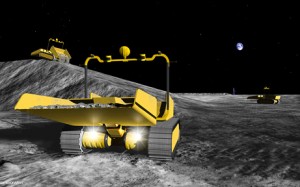Beyond LEO - Flexible Path Revisited

In an interesting post at Vision Restoration, “Ray” tackles the desultory Flexible Path (FP) architecture of the Augustine committee, which calls for human missions to low gravity destinations and delays missions to the lunar and martian surface. The problems he finds with FP are similar to points that I’ve discussed in a previous post.
The principal rationale for doing Flexible Path rather than the current program for return to the Moon is to avoid the cost of developing a new surface lander spacecraft for humans (either lunar or martian), which Augustine pronounced budget-busting for NASA. By being “flexible” and avoiding deep gravity wells, the Augustine committee saw a low cost way to send people beyond LEO. However, the Orion crew module and some type of heavy-lift booster still must be built.
Augustine committee member Jeff Greason discussed the FP architecture during a recent appearance on The Space Show. Jeff pointed out that many people missed the principal rationale for the advancement of FP as an alternative to the existing program – that while we cannot afford the current ESAS architecture because of the requirement to do several developmental projects simultaneously (or nearly so), we might be able to afford to do it sequentially, so that development of the Altair lunar lander would only begin after we had developed and flown the Orion and its new heavy-lift launch vehicle. In his conception of FP, Jeff sees increasing space faring capability over time as robots and people visit new and more distant destinations. The FP destinations described in the Augustine report are the Lagrangian-points, near Earth asteroids, and martian moons Phobos and Deimos.
Ray points out that the two alternatives discussed in the Augustine report (Moon First and FP) assume a roughly $3 billion per year increase in the NASA budget. He suggests that this is unlikely, especially on a continuing basis, a supposition made even more credible by recent stories in the space press. The alternative he offers to Augustine’s FP takes a slightly different tack to the cost problem. Ray’s solution, called Flexible Path to the Moon, shortens the destination horizon for FP and restricts it to cislunar space (GEO, the Earth-Moon L-points, and lunar orbit).
With Flexible Path to the Moon, we develop routine access to all cislunar space, which adds important national security and economic dimensions to the human spaceflight program. Ray would defer not only the Altair lander but also (and this is critical) the new, proposed heavy lift vehicle called for by the Augustine report. Instead, FP to the Moon uses existing and future commercial launch vehicles for LEO access and for the subsequent build up of transfer nodes, in-space re-fueling of vehicles, propellant depots and other features of the Augustine FP architecture. Ray's plan further calls for “a large number” of robotic missions to the Moon and other possible destinations prior to human arrival.
I like this architecture and have advocated a very similar approach that builds up space-faring capability incrementally and cumulatively—take small, affordable steps and make time and schedule the free variables. We make progress as we can with a sustainable architecture and build an infrastructure that is cumulative, inevitable and inexorable. One thing should be added to Ray’s architecture: a statement of the “mission.” The purpose of lunar return is to learn how to use the resources of the Moon and space to create new capabilities and a sustainable human presence in space. This mission statement fits well with Ray’s mission architecture. The significant level of robotic missions that he advocates in Phase 1 can be focused specifically on resource prospecting, characterization and demonstration. We can begin to produce resources using robotic missions and machines teleoperated from Earth well before the arrival of the first humans, who will then have the assets of life-support consumables, propellant, and electrical energy to draw on when they arrive.
The Flexible Path to the Moon offers the build-up of new technologies and capabilities in space by using an incremental approach that falls within existing budgetary constraints. It forgoes the building of a new heavy lift launch vehicle by creating a reusable, extensible space transportation system infrastructure using existing launch vehicles. And it focuses efforts and builds infrastructure in cislunar space, where virtually all of our assets reside. These are the stepping stones we need into the Solar System.
/https://tf-cmsv2-smithsonianmag-media.s3.amazonaws.com/accounts/headshot/blog_headshot_spudis-300x300.jpg)
/https://tf-cmsv2-smithsonianmag-media.s3.amazonaws.com/accounts/headshot/blog_headshot_spudis-300x300.jpg)